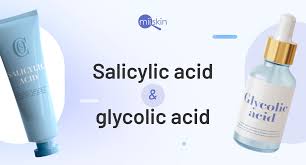
Can You Use Salicylic Acid and Glycolic Acid at The Same Time?
If you are familiar with skincare, you would already understand how both these powerhouse ingredients work on the skin and the benefits you can expect to see. The question we can’t help but wonder though, can you use salicylic acid and glycolic acid at the same time? Let’s investigate further and find out more about the most effective way of benefiting from this skin reviving duo.
This next section will involve a brief refresher on what these ingredients do for the skin, if you are pretty clued up with what glycolic acid and salicylic acid is, you can skip to the next part.
What is Glycolic Acid?
Derived from sugar cane, glycolic acid is one of the most used alpha hydroxy acids (AHAs). Often found in an array of skincare formulas, this potent chemical exfoliant works at sloughing away the layer of dead skin cells that sits on the surface of the skin. Signs of ageing, such as fine lines and wrinkles are visibly reduced, hyperpigmentation and dark spots minimised, blemishes and spots become less frequent with the skin having more clarity.
Once the layer of dead skin cells is removed you will see a noticeable difference in the overall appearance of your complexion and health of your skin. If you wanted to know more about glycolic acid and the benefits it delivers, check out our dedicated blog post.
What is Salicylic Acid?
Salicylic acid is often considered to work in a similar way to glycolic acid, but they are in fact cousins, more than siblings. The main difference between the acids is the fact that salicylic acid is oil soluble meaning it can reach further down into the pores. It can unclog the pores of debris, dirt, and excess sebum. When the pores are blocked with these impurities, you’ll find your skin is littered with blemishes, such as blackheads and whiteheads. Those who have an oily skin type and are prone to frequent breakouts will benefit the most from salicylic acid.
Due to its molecular size being considerably smaller than other acids, it can penetrate deeper meaning for those with dry and sensitive skin will likely suffer from severe dryness and irritation. Therefore, we always suggest consulting with your doctor or GP to ensure you are using the best ingredient for your skin. Furthermore, you can also perform a patch test for 24 hours to double check you will benefit from introducing salicylic acid into your skincare routine.
If you wanted to find out more about salicylic acid, check out our dedicated blog post all about the clever BHA.
Now we’ve had a quick recap, we can dive right into finding out more about these acids and how to use them.
Can glycolic acid be mixed with salicylic acid?
You can certainly use glycolic acid and salicylic acid together, but we would suggest avoiding mixing them together. This is because combining such potent ingredients will cause a severe reaction to the skin, as well as potentially damaging the skin barrier. Once the protective skin barrier is compromised, you will find it is more susceptible to damage because of free radical exposure, such as UV rays, pollution, central heating, and other environmental aggressors.
You can effectively use them together by alternating the stage in your routine you choose to apply your skincare. If you leave at least 10 minutes in between applications for the skin’s pH levels to rebalance and settle, this will avoid unwanted irritation.
Can you use salicylic acid and glycolic acid in the same day?
Yes, you can but as I have already suggested you need to leave enough time for your skin to prepare itself for the next application. Some find that the best way of using glycolic acid and salicylic acid on the same day is to opt for applying a face wash or exfoliating toner enriched in glycolic acid during your morning routine, followed by a serum packed with salicylic acid in the evening.
This works for many as the glycolic acid toner rids the surface of any dead skin cells leaving the skin fully absorbent for the following steps in your routine. Leaving the salicylic acid to use in the evening whilst it works undisturbed from further exposure to free radicals, such as UV rays and pollution. You’ll wake up with a rejuvenated and glowing complexion with clarity and absorbent skin, just ensure you apply a daily SPF of 30 and above to combat any UV damage.
Can I use salicylic acid in the morning and glycolic acid at night?
Absolutely, as I have already mentioned in the previous section, alternating when to apply the ingredients is an easy way of benefiting from each acid’s properties. Although in the previous section I have described how using salicylic acid in the evening is less problematic, many find using it in their morning routine works best for their routine. Using salicylic acid in the morning can be particularly helpful for those who have an oily skin type as the BHA will work deep in the pores and help regulate the sebum production. This will result in the skin staying more matte for a longer amount of time and makeup remaining in place.
Whichever way works for you, just ensure you are using the right ingredients and best formulas for you and your skin. Just because one product works wonders for a friend, doesn’t mean it’ll work for you, pay close attention to how your skin is reacting.
Can I use two products with salicylic acid?
Not really, using too many products containing salicylic acid as this can lead to unwanted skin irritation. This is because multiple percentages of the potent BHA will be too harsh for the skin, even those that have an oily skin, or have built a tolerance to salicylic acid will experience redness, rashes, and increased sensitivity.
You can find out more about what not to use with salicylic acid on a previous blog post that explains everything in more detail.
There you have a little more detail about using salicylic acid and glycolic acid at the same time, don’t forget if you have any further questions, you can find us on Instagram.


